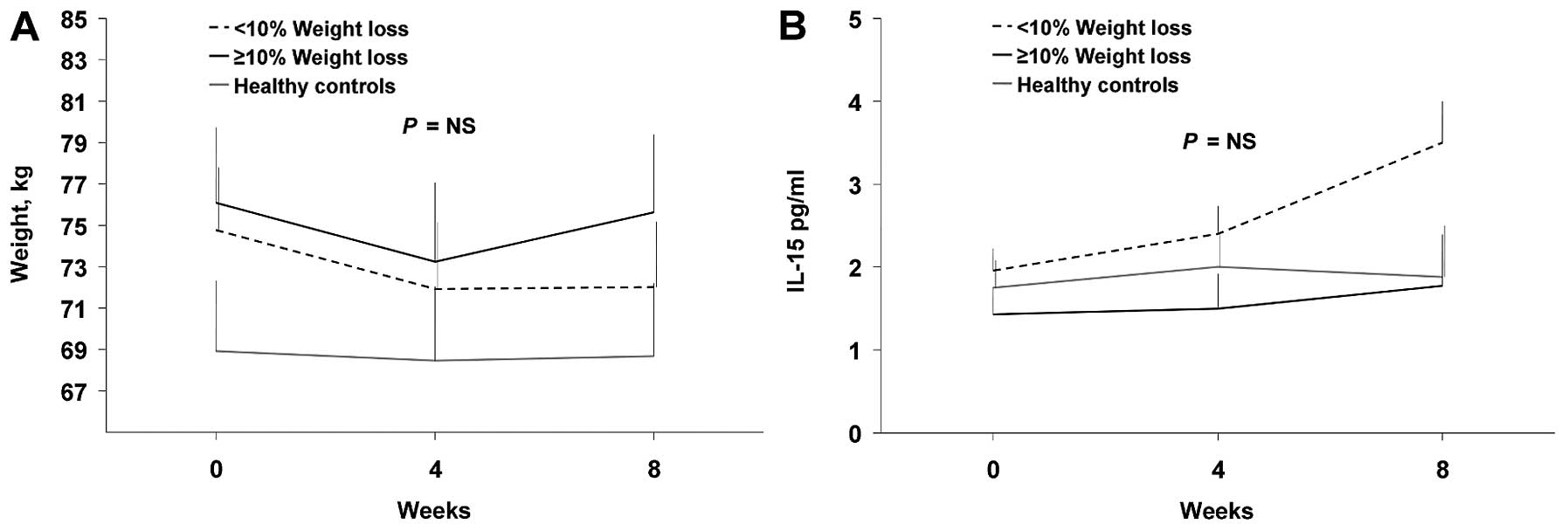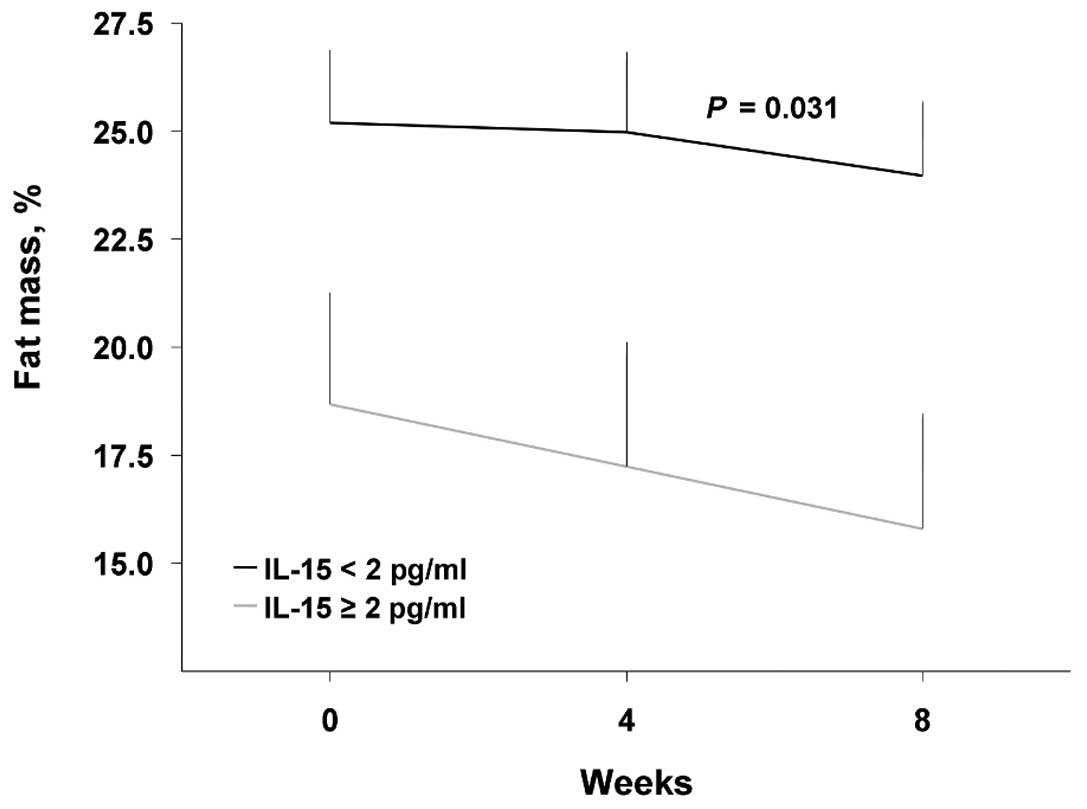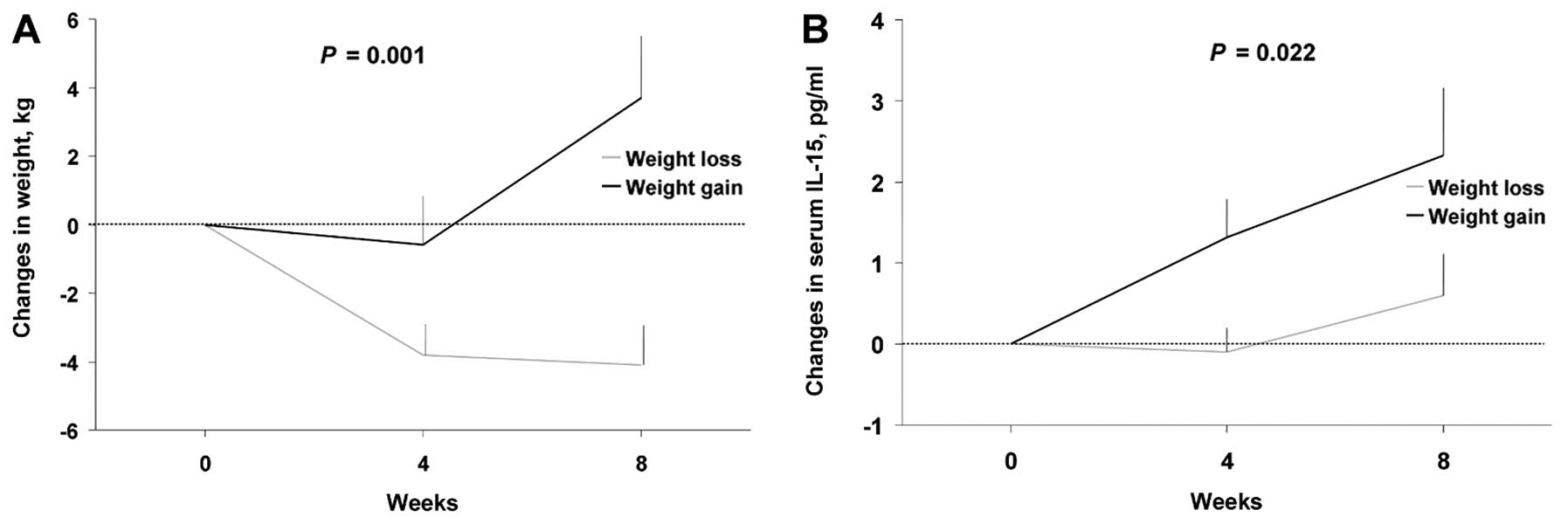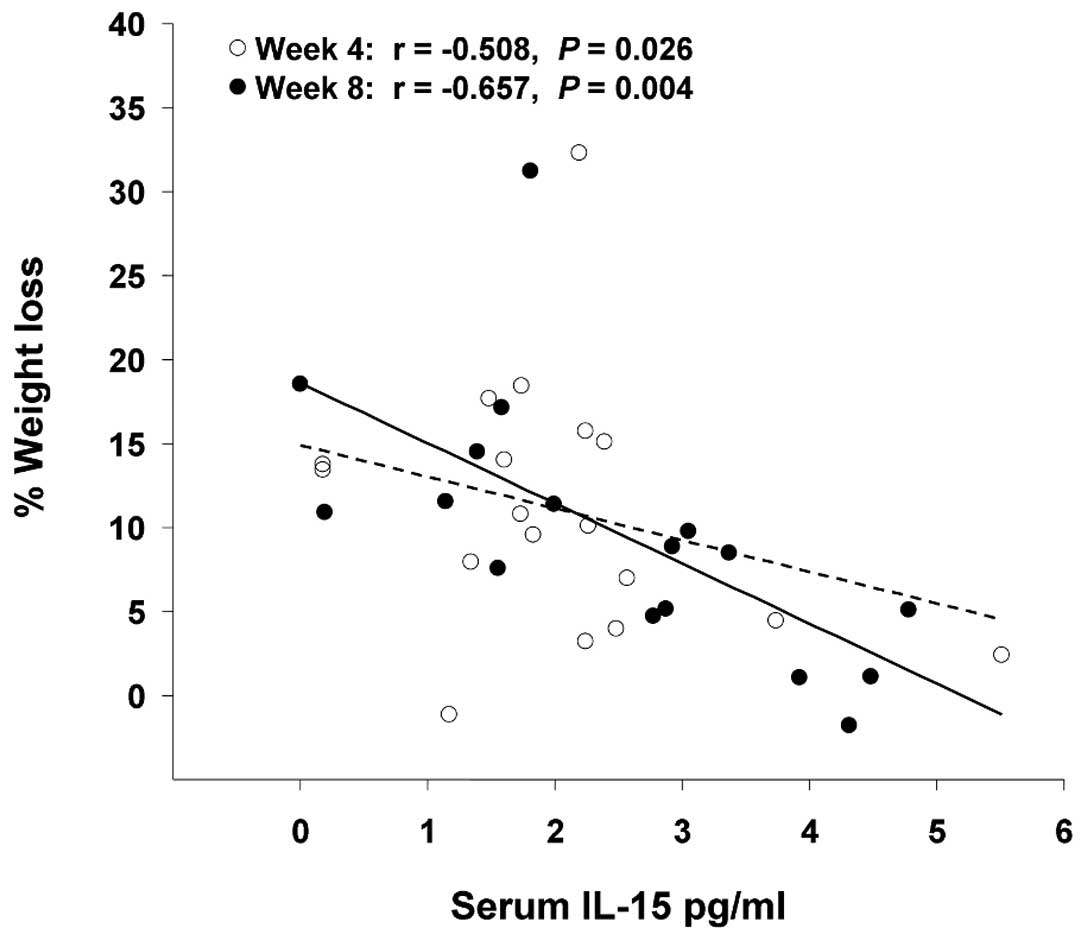|
1
|
Fearon KC, Voss AC and Hustead DS:
Definition of cancer cachexia: effect of weight loss, reduced food
intake, and systemic inflammation on functional status and
prognosis. Am J Clin Nutr. 83:1345–1350. 2006.PubMed/NCBI
|
|
2
|
Evans WJ, Morley JE, Argilés J, Bales C,
Baracos V, Guttridge D, Jatoi A, Kalantar-Zadeh K, Lochs H,
Mantovani G, et al: Cachexia: a new definition. Clin Nutr.
27:793–799. 2008. View Article : Google Scholar : PubMed/NCBI
|
|
3
|
Tisdale MJ: Pathogenesis of cancer
cachexia. J Support Oncol. 1:159–168. 2003.
|
|
4
|
Morley JE, Thomas DR and Wilson MMG:
Cachexia: pathophysiology and clinical relevance. Am J Clin Nutr.
83:735–743. 2006.PubMed/NCBI
|
|
5
|
Dewys WD, Begg C, Lavin PT, Band PR,
Bennett JM, Bertino JR, Cohen MH, Douglass HO Jr, Engstrom PF,
Ezdinli EZ, et al: Prognostic effect of weight loss prior to
chemotherapy in cancer patients. Eastern Cooperative Oncology
Group. Am J Med. 69:491–497. 1980. View Article : Google Scholar : PubMed/NCBI
|
|
6
|
Haehling S and Anker SD: Cachexia as a
major underestimated and unmet medical need: facts and nunber. J
Cachexia Sarcopenia Muscle. 1:1–5. 2010. View Article : Google Scholar : PubMed/NCBI
|
|
7
|
Grabstein K, Eisenman J, Shanebeck K,
Rauch C, Srinivasan S, Fung V, Beers C, Richardson J, Schoenborn
MA, Ahdieh M, et al: Cloning of a T cell growth factor that
interacts with the β chain of the interleukin-2 receptor. Science.
264:965–968. 1994.PubMed/NCBI
|
|
8
|
Burton JD, Bamford RN, Peters C, Grant AJ,
Kurys G, Goldman CK, Brennan J, Roessler E and Waldmann TA: A
lymphokine, provisionally designed interleukin T and produced by a
human adult T-cell leukemia line, stimulates T-cell proliferation
and the induction of lymphokine-activated killer cells. Proc Natl
Acad Sci USA. 91:4935–4939. 1994. View Article : Google Scholar
|
|
9
|
Giri JG, Ahdieh M, Eisenman J, Shanebeck
K, Grabstein K, Kumaki S, Namen A, Park LS, Cosman D and Anderson
D: Utilization of the beta and gamma chains of the IL-2 receptor by
the novel cytokine IL-15. EMBO J. 13:2822–2830. 1994.PubMed/NCBI
|
|
10
|
Quinn LS, Haugk KL and Grabstein KH:
Interleukin-15: a novel anabolic cytokine for skeletal muscle.
Endocrinology. 136:3669–3672. 1995.PubMed/NCBI
|
|
11
|
Quinn LS, Anderson BG, Drivdahl RH,
Alvarez B and Argilés JM: Overexpression of interleukin-15 induces
skeletal muscle hypertrophy in vitro: implications for treatment of
muscle wasting disorders. Exp Cell Res. 280:55–63. 2002. View Article : Google Scholar : PubMed/NCBI
|
|
12
|
Carbó N, López-Soriano J, Costelli P,
Busquets S, Alvarez B, Baccino FM, Quinn LS, López-Soriano FJ and
Argilés JM: Interleukin-15 antagonizes muscle protein waste in
tumour-bearing rats. Br J Cancer. 83:526–531. 2000.PubMed/NCBI
|
|
13
|
Van Royen M, Carbó N, Busquets S, Alvarez
B, Quinn LS, López-Soriano FJ and Argilés JM: DNA fragmentation
occurs in skeletal muscle during tumor growth: a link with cancer
cachexia? Biochem Biophys Res Commun. 270:533–537. 2000.PubMed/NCBI
|
|
14
|
Figueras M, Busquets S, Carbó N, Barreiro
E, Almendro V, Argilés JM and López-Soriano FJ: Interleukin-15 is
able to suppress the increased DNA fragmentation associated with
muscle wasting in tumour-bearing rats. FEBS Lett. 569:201–206.
2004. View Article : Google Scholar : PubMed/NCBI
|
|
15
|
Busquets S, Almendro V, Barreiro E,
Figueras M, Argilés JM and López-Soriano FJ: Activation of UCPs
gene expression in skeletal muscle can be independent on both
circulating fatty acids and food intake. Involvement of ROS in a
model of mouse cancer cachexia. FEBS Lett. 579:717–722. 2005.
View Article : Google Scholar : PubMed/NCBI
|
|
16
|
Zubrod CG, Scheneidermann M, Frei E,
Brindley C, Gold GL, Shnider B, Oviedo R, Gorman J, Jones R Jr,
Jonsson U, et al: Appraisal of methods for the study of
chemotherapy of cancer in man: comparative therapeutic trial of
nitrogen mustard and trietylene thiophosphoramide. J Chron Dis.
11:7–33. 1960. View Article : Google Scholar
|
|
17
|
Utter AC, Nieman DC, Ward AN and
Butterworth DE: Use of the leg-to-leg bioelectrical impedance
method in assessing body-composition change in obese women. Am J
Clin Nutr. 69:603–607. 1999.PubMed/NCBI
|
|
18
|
Ordónez A, Feijoo M and González Barón M:
Evaluación de la Astenia. Valoración clínica del paciente con
cáncer. González Barón M, Lacasta MA and Ordónez A: Editorial
Médica Panamericana; SA Madrid: pp. 79–87. 2006, PubMed/NCBI
|
|
19
|
ATS Committee on Proficiency Standards for
Clinical Pulmonary Function Laboratories. ATS statement: guidelines
for the six-minute walk test. Am J Respir Crit Care Med.
166:111–117. 2002. View Article : Google Scholar : PubMed/NCBI
|
|
20
|
Katz A, Nambi SS, Mather K, Baron AD,
Follmann DA, Sullivan G and Quon MJ: Quantitative insulin
sensitivity check index: a simple, accurate method for assessing
insulin sensitivity in humans. J Clin Endocrinol Metab.
85:2402–2410. 2000. View Article : Google Scholar : PubMed/NCBI
|
|
21
|
Fearon K, Strasser F, Anker SD, Bosaeus I,
Bruera E, Fainsinger RL, Jatoi A, Loprinzi C, MacDonald N,
Mantovani G, et al: Definition and classification of cancer
cachexia: and international consensus. Lancet Oncol. 12:489–495.
2011. View Article : Google Scholar : PubMed/NCBI
|
|
22
|
Lambert CP, Flynn MG, Sullivan DH and
Evans WJ: Effects of megestrol acetate on circulating
interleukin-15 and interleukin-18 concentrations in healthy elderly
men. J Gerontol A Biol Sci Med Sci. 59:855–858. 2004. View Article : Google Scholar : PubMed/NCBI
|
|
23
|
Riechman SE, Balasekaran G, Roth SM and
Ferrel RE: Association of interleukin-15 protein and interleukin-15
receptor genetic variation with resistance exercise training
responses. J Appl Physiol. 97:2214–2219. 2004. View Article : Google Scholar : PubMed/NCBI
|
|
24
|
Spatari G, Fenga C, Minciullo PL, Di
Pasquale G, Cacciola A, Ventura-Spagnolo E and Gangemi S:
Modification of interleukin-15 serum levels in workers exposed to
chemotherapeutic agents. Mediators Inflamm. 1:60–62. 2005.
View Article : Google Scholar : PubMed/NCBI
|
|
25
|
Gangemi S, Basile G, Monti D, Merendino
RA, Di Pasquale G, Bisignano U, Nicita-Mauro V and Franceschi C:
Age-related modifications in circulating IL-15 levels in humans.
Mediators Inflamm. 4:245–247. 2005. View Article : Google Scholar : PubMed/NCBI
|
|
26
|
Yamaji K, Nabeshima S, Murata M, Chong Y,
Furusyo N, Ikematsu H and Hayashi J: Interferon-α/β upregulate
IL-15 expression in vitro and in vivo: analysis in human
hepatocellular carcinoma cell lines and in chronic hepatitis C
patients during interferon-α/β treatment. Cancer Immunol
Immunother. 55:394–403. 2006.
|
|
27
|
Nielsen AR, Mounier R, Plomgaard P,
Mortensen OH, Penkowa M, Speerschneider T, Pilegaard H and Pedersen
BK: Expression of interleukin-15 in human skeletal muscle-effect of
excercise and muscle fibre type composition. J Physiol.
584:305–312. 2007. View Article : Google Scholar : PubMed/NCBI
|
|
28
|
Nielsen AR, Hojman P, Erikstrup C, Fischer
CP, Plomgaard P, Mounier R, Mortensen OH, Broholm C, Taudorf S,
Krogh-Madsen R, et al: Association between interleukin-15 and
obesity: interleukin-15 as a potential regulator of fat mass. J
Clin Endocrinol Metab. 93:4486–4493. 2008. View Article : Google Scholar : PubMed/NCBI
|
|
29
|
Lamana A, Ortiz AM, Alvaro-Gracia JM,
Díaz-Sánchez B, Novalbos J, García-Vicuña R and González-Alvaro I:
Characterization of serum interleukin-15 in healthy volunteers and
patients with early arthritis to assess its potential use as a
biomarker. Eur Cytokine Netw. 21:186–194. 2010.PubMed/NCBI
|
|
30
|
Lissoni P, Rovelli F, Mandala M and Barni
S: Blood concentrations of interleukin-15 in cancer patients and
their variations during interleukin-2 immunotherapy: preliminary
considerations. Int J Biol Markers. 13:169–171. 1998.
|
|
31
|
Pappa C, Miyakis S, Tsirakis G, Sfiridaki
A, Alegakis A, Kafousi M, Stathopoulos EN and Alexandrakis MG:
Serum levels of interleukin-15 and interleukin-10 and their
correlation with proliferating cell nuclear antigen in multiple
myeloma. Cytokine. 37:171–175. 2007. View Article : Google Scholar : PubMed/NCBI
|
|
32
|
Kakumu S, Okumura A, Ishikawa T, Yano M,
Enomoto A, Nishimura H, Yoshioka K and Yoshika Y: Serum levels of
IL-10, IL-15 and soluble tumour necrosis factor-alpha (TNF-α)
receptors in type C chronic liver disease. Clin Exp Immunol.
109:458–463. 1997.
|
|
33
|
Sugaya M, Nakamura K and Tamaki K: Serum
interleukin-15 levels are not elevated in patients with stage I and
II mycosis fungoides. Acta Derm Venereol. 80:4552000.PubMed/NCBI
|
|
34
|
Badoual C, Bouchand G, Agueznay NEH,
Mortier E, Hans S, Gey A, Fernani F, Peyrard S, Laurent-Puig P,
Bruneval P, et al: The soluble alpha chain of interleukin-15
receptor: a proinflammatory molecule associated with tumor
progression in head and neck cancer. Cancer Res. 68:3907–3914.
2008. View Article : Google Scholar : PubMed/NCBI
|
|
35
|
Porrata LF, Inwards DJ, Micallef IN,
Johnston PB, Ansell SM, Hogan WJ and Markovic SN: Interleukin-15
affects patient survival through natural killer cell recovery after
autologous hematopoietic stem cell transplantation for non-Hodgkin
lymphomas. Clin Dev Immunol. View Article : Google Scholar : 2010.
|
|
36
|
Wu S, Fischer L, Gökbuget N, Schwartz S,
Burmeister T, Notter M, Hoelzer D, Fuchs H, Blau IW, Hofmann WK and
Thiel E: Expression of interleukin-15 in primary adult acute
lymphoblastic leukemia. Cancer. 116:387–392. 2010. View Article : Google Scholar : PubMed/NCBI
|
|
37
|
Kuczynski S, Winiarska H, Abramczyck M,
Szczawinska K, Wierusz-Wysocka B and Dworacka M: IL-15 is elevated
in serum patients with type 1 diabetes mellitus. Diabetes Res Clin
Pract. 69:231–236. 2005. View Article : Google Scholar : PubMed/NCBI
|
|
38
|
Prestes J, Shiguemoto G, Botero JP,
Frollini A, Dias R, Leite R, Pereira G, Magosso R, Baldissera V,
Cavaglieri C and Perez S: Effects of resistance training on
resistin, leptin, cytokines, and muscle force in elderly
post-menopausal women. J Sports Sci. 27:1607–1615. 2009. View Article : Google Scholar : PubMed/NCBI
|
|
39
|
Grzegorzewska AE, Mlot M and Leander M:
Serum levels of cancer antigen 125 and interleukin-15 in relation
to the nutrition status of peritoneal dialysis patients. Adv Perit
Dial. 20:185–189. 2004.PubMed/NCBI
|
|
40
|
Carbó N, López-Soriano J, Costelli P,
Alvarez B, Busquets S, Baccino FM, Quinn LS, López-Soriano FJ and
Argilés JM: Interleukin-15 mediates reciprocal regulation of
adipose and muscle mass: a potential role in body weight control.
Biochim Biophys Acta. 1526:17–24. 2001.PubMed/NCBI
|
|
41
|
Alvarez B, Carbó N, López-Soriano J,
Drivdahl RH, Busquets S, López-Soriano FJ, Argilés JM and Quinn LS:
Effects of interleukin-15 (IL-15) on adipose tissue mass in rodent
obesity models: evidence for direct IL-15 action on adipose tissue.
Biochim Biophys Acta. 1570:33–37. 2002. View Article : Google Scholar : PubMed/NCBI
|
|
42
|
Quinn LS, Strait-Bodey L, Anderson BG,
Argilés JM and Havel PJ: Interleukin-15 stimulates adiponectin
secretion by 3T3-L1 adipocytes: evidence for a skeletal
muscle-to-fat signalling pathway. Cell Biol Int. 29:449–457. 2005.
View Article : Google Scholar : PubMed/NCBI
|
|
43
|
Geller MA, Cooley S, Judson PL, Ghebre R,
Carson LF, Argenta PA, Jonson AL, Panoskaltsis-Mortari A,
Curtsinger J, McKenna D, et al: A phase II study of allogeneic
natural killer cell therapy to treat patients with recurrent
ovarian and breast cancer. Cytotherapy. 13:98–107. 2011. View Article : Google Scholar : PubMed/NCBI
|
|
44
|
Dudley ME, Yang JC, Sherry R, Hughes MS,
Royal R, Kammula U, Robbins PF, Huang JP, Citrin DE, Leitman SF, et
al: Adoptive cell therapy for patients with metastatic melanoma:
evaluation of intensive myeloablative chemoradiation preparative
regimens. J Clin Oncol. 26:5233–5239. 2008. View Article : Google Scholar
|
|
45
|
Busquets S, Figueras MT, Meijsing S, Carbó
N, Quinn LS, Almendro V, Argilés JM and López-Soriano FJ:
Interleukin-15 decreases proteolysis in skeletal muscle: a direct
effect. Int J Mol Med. 16:471–476. 2005.PubMed/NCBI
|
|
46
|
Kadowaki M and Kanazawa T: Amino acids as
regulators of proteolysis. J Nutr. 133:S2052–S2056. 2003.
|
|
47
|
Garlick PJ: The role of leucine in the
regulation of protein metabolism. J Nutr. 135:S1553–S1556.
2005.PubMed/NCBI
|
|
48
|
Mitch WE and Goldberg AL: Mechanisms of
muscle wasting. The role of the ubiquitin-proteasome pathway. N
Engl J Med. 335:1897–1905. 1996. View Article : Google Scholar
|
|
49
|
Thomson R, Brinkworth GD, Buckley JD,
Noakes M and Clifton PM: Good agreement between bioelectrical
impedance and dual-energy X-ray absorptiometry for estimating
changes in body composition during weight loss in overweight young
women. Clin Nutr. 26:771–777. 2007. View Article : Google Scholar
|
|
50
|
Evans WJ: Skeletal muscle loss: cachexia,
sarcopenia, and inactivity. Am J Clin Nutr. 91:S1123–S1127. 2010.
View Article : Google Scholar : PubMed/NCBI
|
|
51
|
Malina RM: Variation in body composition
associated with sex and ethnicity. Human Body Composition.
Heymsfield SB, Lohman TG, Wang ZM and Going SB: 2nd edition.
McGraw-Hill Interamericana Editores; S.A. Mexico: pp. 271–298.
2007
|
|
52
|
Rentzos M, Paraskevas GP, Kapaki E,
Nikolaou C, Zoga M, Tsoutsou A, Rombos A and Vassilopoulos D:
Circulating interleukin-15 in dementia disorders. J Neuropsychiatry
Clin Neurosci. 19:318–325. 2007. View Article : Google Scholar : PubMed/NCBI
|
|
53
|
Argilés JM, López-Soriano FJ and Busquets
S: Therapeutic potential of interleukin-15: a myokine involved in
muscle wasting and adiposity. Drug Discov Today. 14:208–213.
2009.PubMed/NCBI
|


















